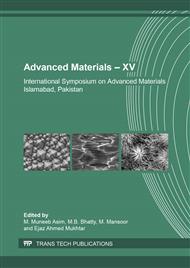[1]
K.M. Hambidge, N.F. Krebs, Zinc deficiency: a special challenge, J. Nutr., 137 (2007) 1101-05.
Google Scholar
[2]
H. Sakurai, Y. Kojima, Y. Yoshikawa, K. Kawabe, H. Yasui, Antidiabetic vanadium (IV) and zinc (II) complexes,Coord. Chem. Rev., 226 (2002) 187-198.
DOI: 10.1016/s0010-8545(01)00447-7
Google Scholar
[3]
A. Shisheva, D. Gefel, Y. Shechter, Insulinlike effects of zinc ion in vitro and in vivo: preferential effects on desensitized adipocytes and induction of normoglycemia in streptozocin-induced rats, Diabetes, 41 (1992) 982-988.
DOI: 10.2337/diabetes.41.8.982
Google Scholar
[4]
H. Sakurai, A. Katoh, Y. Yoshikawa, Chemistry and biochemistry of insulin-mimetic vanadium and zinc complexes. Trial for treatment of diabetes mellitus, Bull. Chem. Soc. Jpn., 79 (2006) 1645-1664.
DOI: 10.1246/bcsj.79.1645
Google Scholar
[5]
M. K. Song, M.J. Rosenthal, S. Hong, D. M. Harris, I. Hwang, I. Yip, M.S. Golub, M.E. Ament, V.L.W. Go, Synergistic antidiabetic activities of zinc, cyclo (his-pro), and arachidonic acid, Metabolism, 50 (2001) 53-59.
DOI: 10.1053/meta.2001.19427
Google Scholar
[6]
Y. Yoshikawa, Y. Adachi, H. Sakurai, A new type of orally active anti-diabetic Zn (II)-dithiocarbamate complex, Life Sci., 80 (2007) 759-766.
DOI: 10.1016/j.lfs.2006.11.003
Google Scholar
[7]
M. Sirajuddin, S. Ali, A. Badshah, Drug–DNA interactions and their study by UV–Vis., fluore-scence spectroscopies and cyclic voltametry, J. Photochem. Photobiol. B: Biol. 124 (2013) 1-19.
DOI: 10.1016/j.jphotobiol.2013.03.013
Google Scholar
[8]
V. González-Ruiz, A. I. Olives, M. A. Martín, P. Ribelles, M. T. Ramos, J. C. Menéndez, An overview of analytical techniques employed to evidence drug-DNA interactions. Applications to the design of genosensors, Biomed. Eng. Trend. Res. Technol., 32 (2011).
DOI: 10.5772/13586
Google Scholar
[9]
W.L.F. Armarego, C.L.L. Chai, Purification of laboratory chemicals, (2013), 7th Ed; Elsevier (USA).
Google Scholar
[10]
S. Dey, S. Sarkar, H. Paul, E. Zangrando, P. Chattopadhyay, Copper (II) complex with tridentate N donor ligand: Synthesis, crystal structure, reactivity and DNA binding study, Polyhedron 29 (2010) 1583-1587.
DOI: 10.1016/j.poly.2010.01.022
Google Scholar
[11]
S. Shujha, A. Shah, N. Muhammad, S. Ali, R. Qureshi, N. Khalid, A. Meetsma, Diorganotin (IV) derivatives of ONO tridentate Schiff base: Synthesis, crystal structure, in vitro antimicrobial, anti-leishmanial and DNA binding studies, Eur. J. Med. Chem. 45 (2010).
DOI: 10.1016/j.ejmech.2010.03.015
Google Scholar
[12]
K. Rizwan, M. Zubair, N. Rasool, M. Riaz, M. Zia-Ul-Haq, V. de Feo, Phytochemical and biological studies of Agave attenuata, Int. J. Mol. Sci. 13 (2012) 6440-6451.
DOI: 10.3390/ijms13056440
Google Scholar
[13]
N. R. Bhalodia, V. Shukla, Antibacterial and antifungal activities from leaf extracts of Cassia fistula l.: An ethnomedicinal plant,J. Adv. Pharm. Technol. Res. 2 (2011) 104-109.
DOI: 10.4103/2231-4040.82956
Google Scholar
[14]
T. Yu, W. Su, W. Li, Z. Hong, R. Hua, M. Li, B. Chu, B. Li, Z. Zhang, Z. Z. Hu, Synthesis, crystal structure and electroluminescent properties of a Schiff base zinc complex, Inorg. Chim. Acta 359 (2006) 2246-2251.
DOI: 10.1016/j.ica.2006.01.019
Google Scholar
[15]
C.D. Sheela, C. Anitha, P. Tharmaraj, D. Kodimunthri, Synthesis, spectral characterization, and antimicrobial studies of metal complexes of the Schiff base derived from [4-amino-N-guanylbenzene sulfonamide] and salicylaldehyde, J. Coord. Chem., 63 (2010).
DOI: 10.1080/00958971003660416
Google Scholar


